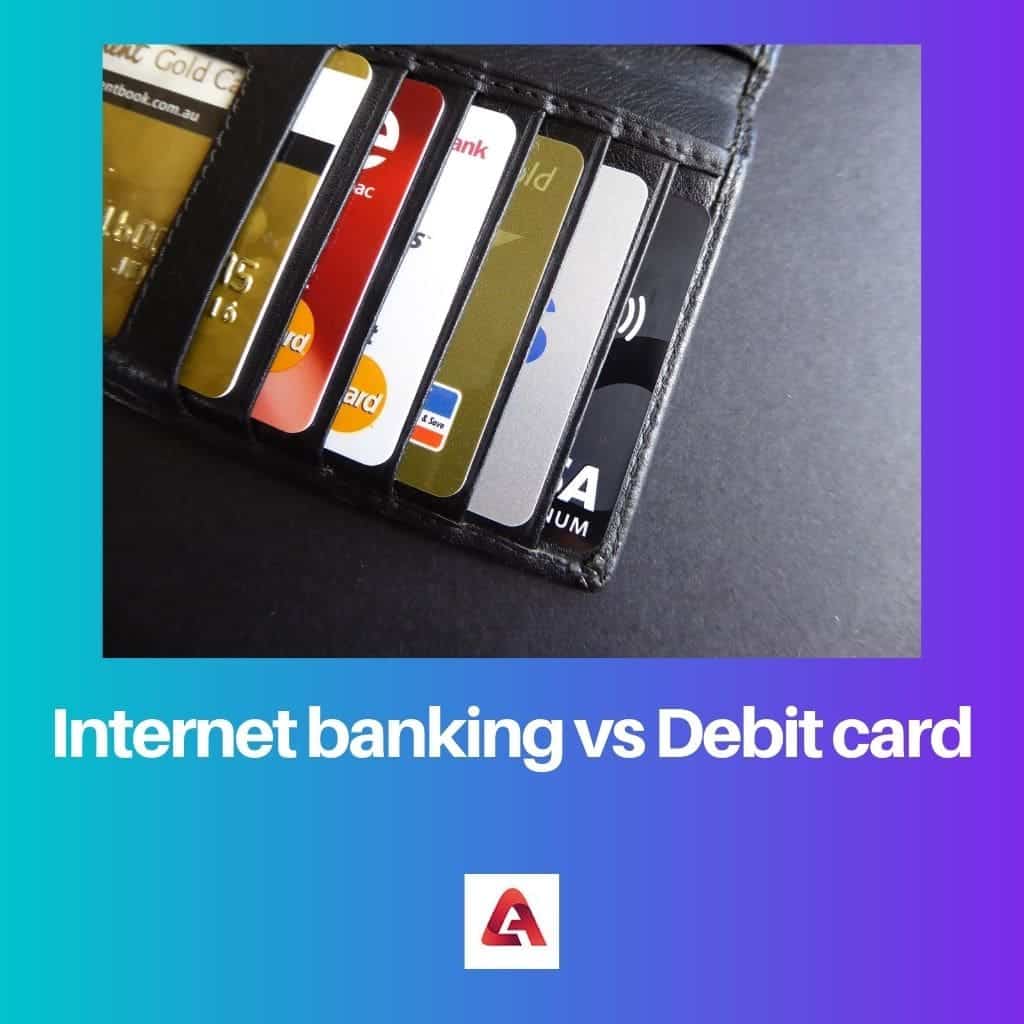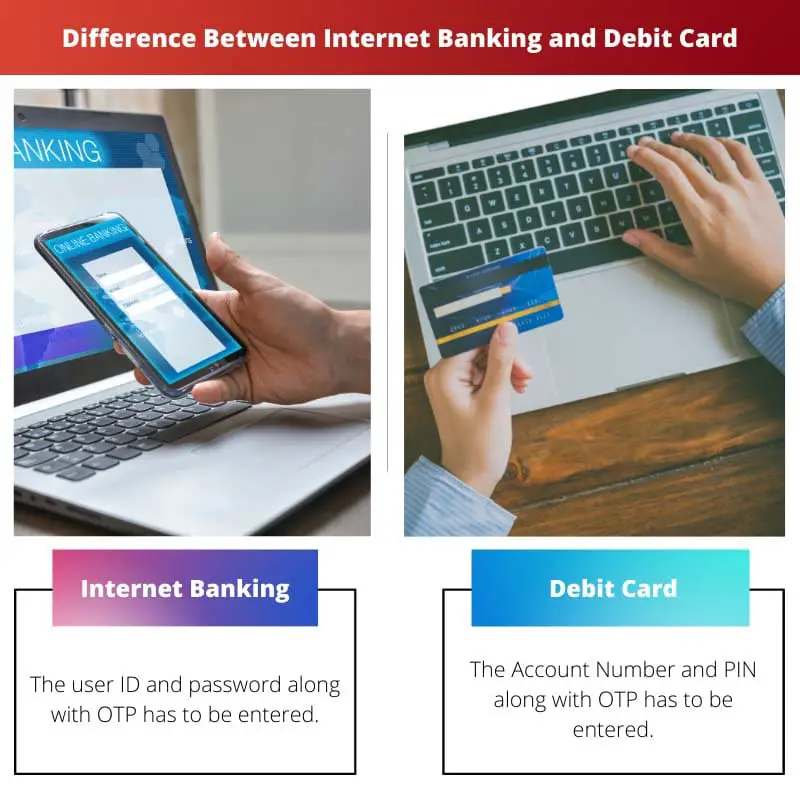Internet Banking and Debit card are two different methods of conducting monetary transactions.
Key Takeaways
- Access: Internet banking requires online access to a user’s bank account, while debit cards are physical cards connected to a user’s bank account.
- Transactions: Internet banking allows users to perform various banking transactions online, while debit cards enable users to make payments and withdraw cash from ATMs.
- Security: Internet banking employs login credentials and multi-factor authentication, while debit cards use a personal identification number (PIN) and card verification value (CVV) for security.
Internet Banking vs Debit Card
The difference between Internet banking and debit card is that while using Internet Banking, the customer is supposed to have an online account on their bank’s official website, and the user ID and password are used for the transaction. On the other hand, in the case of the Debit Card, the customer has to enter their account number and PIN to carry out the transaction online.

Internet banking is carried out through the bank’s official website, whereas the account number must be entered to use a Debit Card. The Debit Card is also used to withdraw cash from the ATM.
Internet Banking is a system that facilitates the online transfer of funds from account to account through the customer’s net banking account.
A debit Card is a card(plastic) used during transactions to avoid using cash.
Comparison Table
| Parameter of Comparison | Internet Banking | Debit Card |
|---|---|---|
| Method of transaction | The user ID, password, and OTP must be entered. | The Account Number, PIN, and OTP must be entered. |
| Safety | No credentials are saved with Merchant’s website, thus safe. | Banking details are saved with the website, thus unsafe. |
| Authentication Steps | OTP/IVR verification steps are taken. | 3D Secure Verification steps taken. |
| Process | Transactions are routed through banks. | Transactions are routed through card issuers like VISA and MasterCard. |
| Offers and Loyalty Points | It does not provide cashback, recommendations, or loyalty points. | Provides up to 1-2% cashback, loyalty points, and multiple offers on Debit Card. |
What is Internet Banking?
Internet banking is an arrangement that offers the ability of a customer to carry out monetary transactions from their banking account. Using the bank’s official website, the user can transfer funds to other versions of the same bank or a different bank from their account.
The intermediate that facilitates this technology is the Internet. It acts as the medium.
To carry out internet banking, electronic devices are needed. Generally, a mobile phone, computer or laptop is used.
Internet banking is made available to customers through and by the banks. To avail of this facility, the customer must have an account in any bank.
When you pay through internet banking, then as you select the payment through internet banking option you are directed to the bank’s login site. There you enter your id and password.
Then you confirm your payment by accepting the terms and receive an OTP (one-time-password), after which the transaction is complete.
The benefits of net banking are:
- It doesn’t need you to enter the card number, CVV number, etc., every time you make a payment.
- Internet banking transactions are routed through the bank.
- Internet banking has another ladder of authentication provided by OTP on your mobile phone, making transactions more secure.
- The cost of internet banking transactions to banks is cheaper than that of a debit card transaction.
- Internet banking also provides various functions like the creation of RD, the result of FD, account statements, and the best functionality of paying off bills.

What is Debit Card?
It is a card for payment that subtracts money straight from the customer’s savings account to carry out a transaction. Debit cards eradicate the use of cash or cheques and cut the money directly from your savings.
Debit cards are distributed by processors such as Mastercard or Visa.
When you choose payment through a debit card, then on the service provider’s or merchant’s website, you have to enter your debit card number, which is a 16-digit or, in some cases 19, digit number, which gets saved on these websites. After saving these numbers, you are directed to the bank’s website, where you must give your card PIN to complete the transactions.
In the case of Debit cards, the transaction has to be routed through an Acquiring Bank (not the same as the Debit card issuing bank, in most cases) that, in turn, communicates with an integrated gateway and Switch of that bank.
The transaction then, via a card Network (Mastercard/Visa, etc.), get routed to the Debit card issuing bank, where it gets authorized after checking for funds in the cardholder’s account by the CBS of the (issuing) bank. The approved/declined message is returned to the Merchant and the customer through the same route.

Main Differences Between Internet Banking and Debit Card
- The main difference between Internet Banking and Debit Cards is that the transaction happens in the customer’s bank domain in net banking. The customer is routed to his bank domain. While A debit or credit card transaction happens in the acquirer domain, i.e. card number is captured by the payment processor/acquirer.
- In Internet Banking, no credentials are saved on the website where the transaction is being carried out, whereas, while using the Debit Card, account details are saved with the Merchant’s website.
- In Internet Banking, OTP(one-time-password) or IVR( interactive voice response) system. is set into place for authentication, while a Debit Card uses the 3D secure System.
- The primary difference between paying through Internet banking and a Debit card is that you will get an 8-digit OTP for Net banking and 6 digit OTP for Debit cards.
- It is not possible to withdraw cash through Internet Banking. Whereas through a Debit Card, cash withdrawal can be made by using an ATM and entering the PIN.




